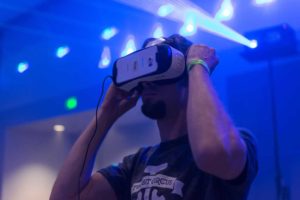From recruitment to distance learning, and from alumni relations to more culturally diverse courses, virtual reality has mass appeal to today’s institutions.

Virtual reality (VR) is emerging as a powerful technology, projected to grow into a $30 billion industry in the next 5 years. Major brands across various industries have already begun using VR as a marketing tool to get customers to try their product, service, or visit their location. But when it comes to higher education, has VR’s dramatic rise impacted colleges and universities?
Virtual reality: The Ultimate Recruiting Tool
Many schools are already taking advantage of VR technology for marketing purposes; in fact, the vast majority of top institutions are using it to recruit prospective students in a variety of ways. In a sense, virtual reality is the perfect tool for student recruitment, as it allows colleges to effectively reach, engage, and appeal to prospective students through virtual campus tours.
Savannah College of Art and Design (SCAD) was an early adopter in utilizing this technology. Last spring, the art school created immersive virtual reality experiences of SCAD sites around the world, allowing viewers to immerse themselves in these environments and feel as though they actually visited the locations in person. SCAD then mailed 10,000 inexpensive cardboard VR headsets to students who had been accepted to the school, but not yet enrolled, allowing them to entice the students, as well as get a leg up on the competition.
“Virtual reality is one way you cannot just see but experience a place,” SCAD’s Vice President of IT, Brad Grant, told the LA Times. “If you’re talking about a painting studio, we can get a camera assembly inside that environment, and when you put on the goggles you can experience what it would be like to be in a painting studio full of students.”
This technology can also be incorporated into off-site efforts, including college fairs. Texas’ Trinity University has used their virtual tours in similar ways to help students better connect with the school.
“We bring VR on admissions events, to conferences, and encourage alumni to use the VR tour to reconnect with campus, see new buildings, and remember their time at Trinity,” said Michelle Bartonico, Trinity’s director of marketing communications.
However, the power of VR goes beyond simply recruiting. The University of Michigan uses the technology as a learning tool, and by instituting a virtual reality “cave” they’ve allowed engineering students to interact with virtual structures as they “come together, buckle and collapse.” Instead of relying on physical models—which tend to be large, expensive, and slow to build—a student using the MIDEN VR cave can fly around a virtual structure to study mechanical connections.
(Next page: Looking to the near future)
The Future of Virtual Reality in Higher Ed
Looking to the future, as adoption of VR increases among universities, the technology will be used in more innovative ways.
Currently, universities offer options for distance learners to take online classes; soon, colleges will use VR technology to fully immerse students in the college experience, allowing them to feel present in a classroom discussion or lecture, regardless of distance. Universities can either record these experiences for later use, or use live-streaming virtual reality—a technology that has only recently begun to catch on with major brands and institutions.
The combination of all this technology could result in something like a virtual Rhodes Scholar program, where students can take part in live classes with top professors at universities all over the world, without having to leave their regular school.
The technology will also offer an invaluable means of learning for those in the social sciences and medical fields, which often require “hands-on” experiences. Eventually, VR technology will allow students to be placed in the shoes of patients to give them insight into how they experience the world. Organizations like the Virtual Human Interaction Lab are already studying the psychological effects of VR as related to empathy. This could allow future public policy students to experience first-hand what it means to be a refugee in a third-world country, or optometry students to experience what life is like for the vision-impaired.
Outside of lectures and hands-on learning, VR also offers schools the chance to immerse students in important cultural events. Educators are already using video to enhance lessons; in the near future, VR will be used in a similar manner. For example, instead of having students watch political debates on TV or YouTube in the classroom, professors can allow them to immerse themselves in the debates, making them feel as though they were actually there in the crowd. In fact, some major media networks are already experimenting with this type of content.
In addition to utilizing the technology to support individuals before and during their college experience, universities could also use VR to foster a vibrant alumni community. Virtual reality technology could allow former students to virtually attend major sports games, or even take part in virtual networking events for past and present students to meet and discuss their time at a particular university.
As the popularity of virtual reality products and applications grows over the next five years, industries will begin to find new and creative ways to take advantage of the technology. For colleges and universities in particular, virtual reality technology creates immense opportunities, from student recruitment to the actual learning processes and beyond.
Abi Mandelbaum is co-founder and CEO of YouVisit, a fully integrated platform for creating, distributing, and monetizing virtual reality and other immersive experiences across all devices, including headsets, mobile, and desktop.

